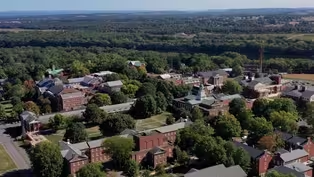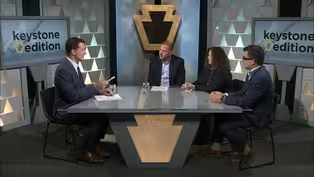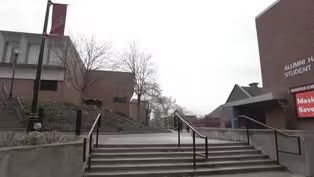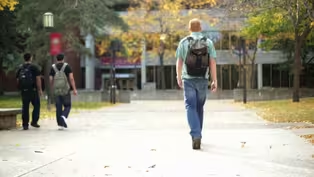Keystone Edition
Remote/Hybrid Learning, Competition, and Economic Impact
Clip: 10/14/2024 | 8m 25sVideo has Closed Captions
Learn about the innovations happening in higher education.
The panel dives into the shifts caused by COVID-19, including the rise of remote learning and hybrid models, and how these changes are shaping student enrollment and the future of local institutions. They explore the increasing competition schools face, the role of credentialing programs, and the economic impact colleges have on local communities.
Problems playing video? | Closed Captioning Feedback
Problems playing video? | Closed Captioning Feedback
Keystone Edition is a local public television program presented by WVIA
Keystone Edition
Remote/Hybrid Learning, Competition, and Economic Impact
Clip: 10/14/2024 | 8m 25sVideo has Closed Captions
The panel dives into the shifts caused by COVID-19, including the rise of remote learning and hybrid models, and how these changes are shaping student enrollment and the future of local institutions. They explore the increasing competition schools face, the role of credentialing programs, and the economic impact colleges have on local communities.
Problems playing video? | Closed Captioning Feedback
How to Watch Keystone Edition
Keystone Edition is available to stream on pbs.org and the free PBS App, available on iPhone, Apple TV, Android TV, Android smartphones, Amazon Fire TV, Amazon Fire Tablet, Roku, Samsung Smart TV, and Vizio.
Providing Support for PBS.org
Learn Moreabout PBS online sponsorship(air whooshes) - Well, Teri, bringing you to the conversation now.
I want to ask about schools were impacted by COVID-19 pandemic.
They shifted their whole model of learning to remote.
Many institutions have kept that integrated into how they deliver the education side by side with being a place, bricks and mortar.
Talk about those shifts, and are there parts of that that are impacting the change in enrollment, students seeking just different models of education?
- Well, I think that it really opens the door for students to think beyond the boundaries they may have had prior to COVID.
There are more remote opportunities.
Many of the schools in our area have 100% remote programming, and it's very attractive.
We're finding out that to engage that younger demographic, there has to be some component of remote schooling, hybrid working.
It's very different than it was pre COVID.
It became very appealing to that generation to have that opportunity.
And so schools are adjusting.
We're seeing those remote classes, programs.
We're seeing a greater emphasis in the trades as more people become aware of the incredible family sustaining jobs that exist and apprenticeship opportunities and working with the trade schools and the unions to get employment.
Also, as we become more technologically advanced, stacked credentialing becomes something that is imperative and without necessarily that four year degree for information technology because in an effort to stay current with the technology, you need ongoing education.
And so many of our schools in the area have added different types of credentials in specialty areas to attract students.
What this does is create opportunity because there are students that are definitely not college-ready or never wanna be college-ready, but there are opportunities for some post-secondary education.
And we find that regardless of whether it's credentialing or that four year degree, that added post-secondary education helps individuals earn family sustaining wages and be economically mobile throughout their lifetime.
So, it creates opportunity, but, of course, it creates the stress on the schools.
It forces them into a competition that they've not necessarily been in before.
You know, they may be competing regionally, but now they could be competing nationally.
But that opportunity also can allow you to bring students in from other countries even and expand your international programs, which I know Wilkes University has done dramatically in the past couple years.
So, it has a tendency to work both ways, and it's a careful balancing act.
I certainly wouldn't wanna be a college president right now and have to manage that kind of a thing, but it is vital to our communities.
You know, Larry sees this firsthand.
I mean, he had all of the numbers there, which is why we get along so well with the data.
But I ran an economic model today just looking at what an average college and university in Northeastern Pennsylvania is with number of employees and wages and annual revenue.
And several of our schools are contributing about $90 million in economic activity a year.
And that's the rippling through the economy.
So it's the direct effect of all their employment and the wage taxes they pay and the insurance they buy and all the goods and services, but it also accounts for the student spending, their parents spending as visitors, and it affects every sector of the economy, every single sector from housing to retail of everybody's spending power.
So it's devastating for smaller communities if a college were to go under.
- If there's a loss.
Larry.
- I'll just drill down from what Teri said, you know, and I'll zoom in from the broader impacts that she described.
We last did a survey of college student spending in Downtown Wilkes-Barre in 2018.
And when we did that, we found that the college students responding to our survey reported that in the prior week, they had spent on average $42 during that week at Downtown Wilkes-Barre businesses.
About $25 of that was on food and beverage.
The rest was for other services.
So that gives you an idea in terms of order of magnitude of just what kind of spending impact each individual student alone is having in their host communities.
- And how about when their families visit, when there are alumni events?
- You can just extrapolate it out and you understand what that means for overnight stays.
You understand what that means for... And I think those are the direct impacts.
I think what we haven't necessarily even looked at yet is what that pipeline of students means for the future of our region's economy and how these schools, these colleges and universities are contributing both by educating students from our region, but also students who are coming from outside of our region and potentially choosing to build lives and careers in Northeastern Pennsylvania, what that means for the future of our region.
- You can think of Pennsylvania as having an education economy, and there's both imports, students coming in, as well as exporting, students going out.
Dan, I know you wanna jump in on this.
- Yeah, just, you know, because it's not just that what we're trying to break out of is that traditional four year, 18 to 22.
If we want to be sustainable, and we know this, and if we want to compete now, we have to be thinking of other ways to reach people.
So our local industries, you know, I'm most proud of the Columbia Montour Chamber of Commerce.
We've partnered with them.
We have manufacturers around our Bloomsburg campus.
Folks don't need a two year degree even, but they might need a certificate in leadership or management because they're gonna be a shift supervisor.
We've been able to fill that need.
We have a CDL licensing program through Commonwealth University.
In August, we just signed an agreement with the Pennsylvania State Police.
So if you're a cadet and you finish the academy, you wanna do a criminal justice BA, you don't have to start from square zero.
You shouldn't because you just went through.
You know, you're a state police officer.
We're gonna give you credit for prior learning so that you have a head start.
And I think you mentioned dual enrollment earlier.
We have 500 students, high school students taking courses at one of our campuses.
So, you know, when we say students, that's the other half of it.
It's just getting out of that mindset that it's just the four year traditional 18 to 22 year olds.
- Sounds like a lot of innovations happening in the business model of universities and the way in which students are seeking and receiving education.
Teri, a final thought on that?
- I think this region is really poised for incredible opportunity because of the higher education infrastructure.
Yes, there's some risk, but the bottom line is the population globally is diminishing.
Nationally, it's diminishing.
So those workforce demands are critical for our businesses to survive.
And if we have the educational institutions connecting with the business, that's really our economic sustainability for the future is workforce.
Whoever has the workforce is gonna have an economically viable region.
I think we got it.
- Well, Teri, thank you so much for the perspective you bring from the institute, Dan, from your role at Commonwealth University, Larry, keep up the great work at Diamond City Partnership.
Great to hear of the things that are happening in Wilkes-Barre.
And for more information on this topic,
Clip: 10/14/2024 | 2m 14s | At Bucknell, strategic initiatives have led to record-breaking enrollment for 3 consecutive years. (2m 14s)
Challenges and Opportunities for Higher Education
Video has Closed Captions
Clip: 10/14/2024 | 12m 23s | This clip highlights the challenges faced by institutions as they navigate declining enrollments. (12m 23s)
Education on the Edge - Preview
Preview: 10/14/2024 | 30s | Watch Monday, October 14th at 7pm on WVIA TV (30s)
Clip: 10/14/2024 | 1m 43s | An explanation of the factors contributing to an impending enrollment decline at local universities (1m 43s)
Providing Support for PBS.org
Learn Moreabout PBS online sponsorship
- News and Public Affairs

Top journalists deliver compelling original analysis of the hour's headlines.

- News and Public Affairs

FRONTLINE is investigative journalism that questions, explains and changes our world.












Support for PBS provided by:
Keystone Edition is a local public television program presented by WVIA



